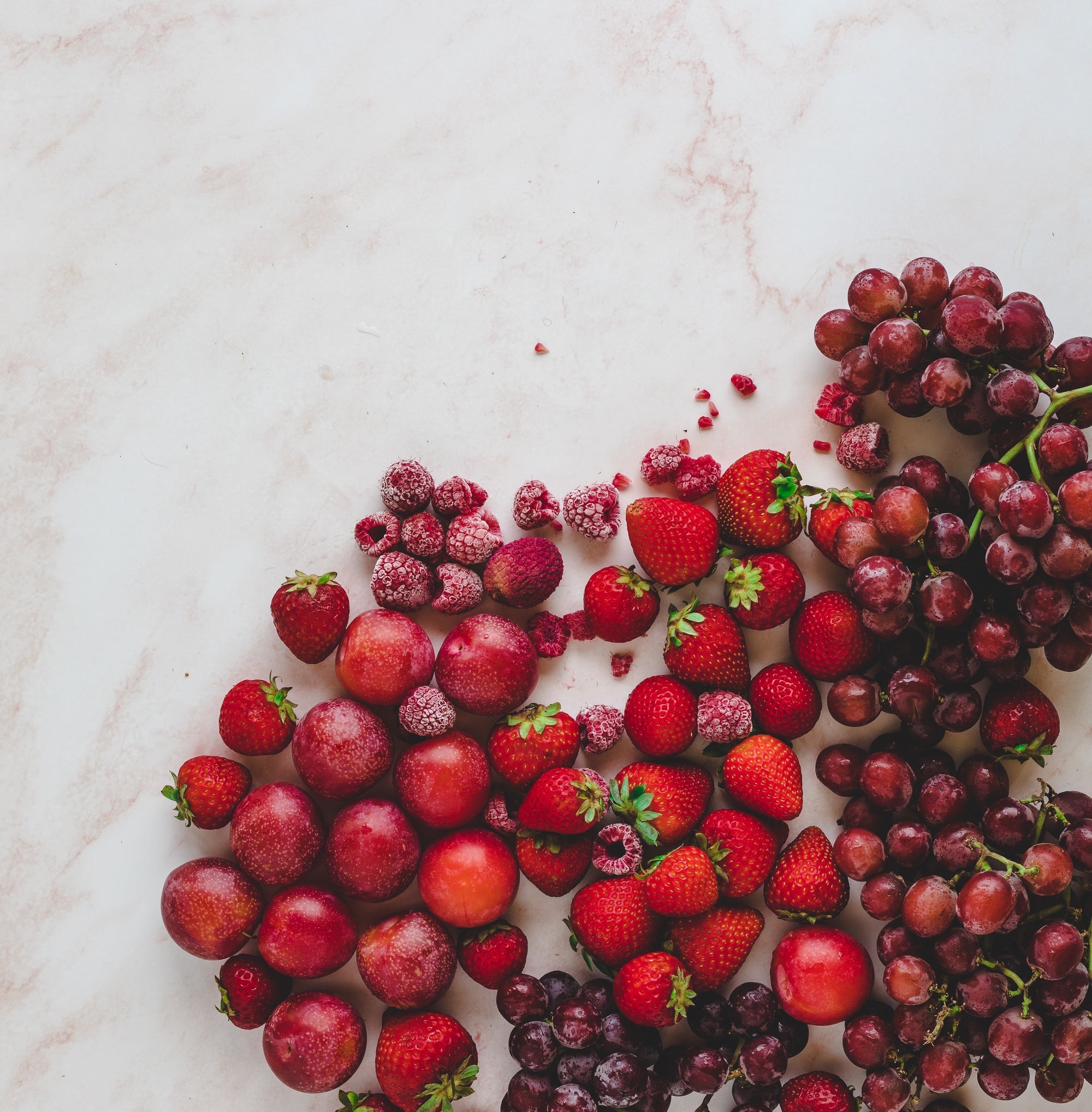
Antioxidants. You’ve heard about them – from food, drink, skincare and supplements, to exotic fruits, like goji berries, acai, and wild blueberries having their moment in the superfood spotlight for high antioxidant content. Even JOYÀ’s Functional Chocolates are a great source of antioxidants.
If you’re familiar with the term “antioxidants”, but not quite sure exactly what they are or why they’re important, keep on reading. This one’s for you!
What are Free Radicals?
Before we dive into antioxidants, we first need to discuss free radicals—the very reason why antioxidants are so needed! So what are they, and why don’t we want them?
Free radicals; the anti-antioxidant
Time to travel back to highschool chemistry. Remember atoms, molecules, ions and electrons? Well, a free radical in its simplest definition is an atom, ion or molecule that has one unpaired electron. In other words, it's chemically reactive, unstable and looking to steal an extra electron and bind with another atom or molecule to become stable.
Free radicals occur naturally in the body as a result of metabolism and nutrient breakdown. As we age and metabolism slows, an increased number of free radicals contributes to the aging process.

Free radicals can also be produced when we're exposed to environmental and other toxins such as air pollution, alcohol consumption, tobacco smoke, and UV radiation, as well as due to periods of high stress, poor blood sugar regulation, exercise and poor diet.
The body is equipped to neutralize and rid the system of free radicals. However, when there is an excess, that’s when trouble can start. More on that below.
Free radicals, oxidative stress and health
When the body is faced with an overload of free radicals that cannot gradually be neutralized, their accumulation in the body results in a state called oxidative stress. Increased oxidative stress can lead to inflammation, which plays a major role in the development of chronic and degenerative illness, including:
- Alzheimer’s disease, diabetes, cancer, autoimmune disorders, rheumatoid arthritis, cardiovascular and neurodegenerative diseases
- Premature aging as it relates to skin, including excess wrinkles, dryness, pigmentation, sagging and texture issues.
- Vision disturbances such as cataracts, macular degeneration and glaucoma.
What are the benefits of antioxidants?
Antioxidants are compounds that help protect your cells against free radical damage. Think of antioxidants as little scavengers or defenders in the body that target free radicals, donate missing electrons, and stabilize the once unstable free radical. In this manner, these powerful antioxidants counteract oxidative stress, and in turn, reduce the damage that free radicals can cause in the body.
So how do we get lots of antioxidants in our body?
There are two sources of antioxidants: those naturally produced by our body, and antioxidants supplemented through food and/or supplements.
Three of the most powerful antioxidants produced by the body
Glutathione is considered a master antioxidant in the body. It can be found in nearly every one of the body’s cells where it provides protection, while simultaneously helping to recycle other antioxidants used by the body.

Need more Glutathione? Moderate aerobic exercise (like jogging, walking and swimming) and weight training can increase glutathione levels, and sulfur containing foods like alliums and cruciferous vegetables can supply the body with the building blocks needed to help facilitate glutathione production.
Coenzyme Q10 is an antioxidant found throughout the body. It’s made primarily by the mitochondria – the energy powerhouse of the cell – with the highest levels found in the heart, liver, kidney and pancreas. As a coenzyme, it also assists essential enzymes involved in energy production. In times of stress or as we age, our requirements for Coenzyme Q10 increase, and because the body cannot always synthesize sufficient amounts, extra Coenzyme Q10 should be supplemented or obtained from food.
Consume Coenzyme Q10 by including fatty fish, organ meats, organic soybean, broccoli, pistachios and sesame seeds.
Melatonin, a hormone most often associated with helping manage circadian rhythms and sleep cycles, is produced primarily by the pineal gland in the brain. Aside from being a hormone, melatonin has antioxidant effects and is considered an “unrivaled multitasking molecule”, acting as an effective free radical scavenger as well as improving the efficiency of other antioxidants.

Make more melatonin: get sunlight during the day, sleep in a completely dark room and consume foods like cherries, grapes, strawberries, eggs, milk, fish and nuts (pistachios in particular).
Seven of the most powerful antioxidants found in food
Anthocyanins are responsible for giving certain foods their natural blue, red, or purple color. And aside from acting as antioxidants, research shows that a diet high in Anthocyanins can also help keep inflammation low.

Rich sources of Anthocyanins: fruits and vegetables like black plums, blood oranges, cherries, black and red grapes, pomegranates, red cabbage, red onions, red radishes, purple cauliflower, purple corn and the skin of purple eggplant.
Carotenoids are considered excellent free radical scavengers that are naturally found in plants. They give plants their purple, reddish and yellow colors. B-carotene is the most notable carotenoid, which the body can convert into vitamin A, an important factor of eye health.
Add Carotenoids to your cart: brightly colored fruits and vegetables like carrots, cantaloupe, broccoli, spinach, kale, corn, orange bell peppers, tomatoes, watermelon and pink grapefruit.
Catechins have both direct and indirect antioxidant properties, scavenging for free radicals, as well as activating other antioxidant pathways. They are the most abundant antioxidants in green tea and matcha, and the reason for tea's high antioxidant activity.

Catch all the catechins; aside from green tea and matcha, other great sources include: apples, blackberries, dark chocolate, red wine, cherries, guava, pears, fava beans and sweet/purple potatoes.
Resveratrol is a polyphenol, a group of micronutrients found in plants, with the ability to fight free radicals and reduce inflammation.
Reach for resveratrol: it’s naturally found in the skins of red grapes (and therefore red wine), blueberries, and peanuts.
Selenium is a trace mineral that works as an antioxidant in the body and plays an important role alongside glutathione, the master antioxidant, in reducing free-radicals and oxidative stress in the body.

Sources of Selenium? Brazil nuts are one of the best!
Vitamin C, although typically thought of as an immune booster, also works as a powerful antioxidant to neutralize free radicals and protect against oxidative stress, especially when paired with vitamin E. Vitamin C is found in many skincare products to promote collagen production and protect against UV damage.
Eat your vitamin C by including fruits and veggies like acerola cherries, rosehips, peppers, guava, broccoli, tomatoes and citrus fruit on a daily basis.
Vitamin E is a name for a group of eight similar fat-soluble vitamins (tocopherols and tocotrienols) with antioxidant properties that help stop the production of cell-damaging oxidative stress and support the immune system. It’s a popular ingredient in skincare to reduce scar tissue and UV damage.
Up your Vitamin E with food sources like nuts (such as almonds, peanuts, and hazelnuts), sunflower seeds, spinach, and broccoli.
Foods with the highest antioxidants levels
In order to rank foods based on antioxidant levels, we need a way to calculate antioxidant levels. Enter the ORAC scale. ORAC, short for Oxygen Radical Absorbance Capacity, is a unit of measurement for antioxidant content used to rank foods and herbs from “superfood” status on down.

So what tops the ORAC list?
With a full list of over 3000 products tested for antioxidant levels, some of the most notable foods and herbs include:
- Allspice
- Chokeberries/Aronia
- Cinnamon
- Cloves
- Coffee
- Dark chocolate
- Ginger
- Green tea/Matcha
- Holy Basil
- Lemon balm
- Walnuts
- Wild blueberries
- Wild rose
JOYÀ Functional Chocolate; Antioxidants galore!
Something that all of JOYÀ’s products have in common — aside from being chef-crafted, 100% free of junk ingredients and powered by adaptogens — is that they’re a great source of antioxidants. Our Functional Chocolate features ingredients such as cacao, as well as functional herbs and mushrooms including rhodiola and reishi with unique antioxidant properties.
Below are some of the top antioxidant-rich ingredients in each Functional Chocolate. That’s right, they’re antioxidant-packed!
Focus Functional Chocolate: Cacao, Cacao butter, Coconut, Coffee, Ginkgo biloba, Rhodiola
Zen Functional Chocolate: Cacao, Cacao butter, Coconut, Reishi Mushroom
Defend Functional Chocolate: Cacao, Cacao butter, Coconut, Lion’s Mane Mushroom, Astragalus
Balance Functional Chocolate: Cacao, Cacao butter, Coconut, Reishi mushroom
Amp up on antioxidant-rich recipes from the JOYÀ Life Blog
With such a wide array of fruits, veggies, herbs, spices and even dark chocolate available to us, including antioxidants in your everyday routine doesn’t have to be complicated.
We love a yogurt parfait with organic berries and chunks of chocolate, a generous sprinkle of cinnamon in our coffee, and the possibilities are endless with smoothies and chia puddings like some of our favorites:
Post-Workout Berry and Nut Butter Recovery Smoothie
Matcha Golden Milk Layered Chia Pudding Parfait
Dark Chocolate Peanut Butter Bites
The Bottom Line
Free radicals and oxidative stress are a part of life through metabolic and naturally occurring processes in the body. Regularly incorporating a large array of fruits, veggies, nuts, seeds, plants and sustainably sourced meat and fish into the diet not only helps supply the body with antioxidants but also supports antioxidant production. So now you know. Get your antioxidant on.
Sources
Oxidative stress, aging, and diseases | tandfonline.com
Free Radicals, Antioxidants in Disease and Health | PMC
Oxidative Stress in Aging Human Skin | PMC
Oxidative Stress in Ophthalmology | AAO
The antioxidant master glutathione and periodontal health | PMC
A Review of Dietary (Phyto)Nutrients for Glutathione Support | PMC
Effects of exercise training on the glutathione antioxidant system | Oxford Academic
Sulfur compounds: From plants to humans and their role in chronic disease prevention | tandfonline.com
CoQ10 a super-vitamin: review on application and biosynthesis | PMC
Coenzyme Q10 | OSU
Melatonin’s Impact on Antioxidative and Anti-Inflammatory Reprogramming in Homeostasis and Disease | PMC
Dietary Sources and Bioactivities of Melatonin | PMC
State of the Art of Anthocyanins: Antioxidant Activity, Sources, Bioavailability, and Therapeutic Effect in Human Health | PMC
Potential Role of Carotenoids as Antioxidants in Human Health and Disease | PMC
The Role of Catechins in Cellular Responses to Oxidative Stress | PMC
Resveratrol: A Double-Edged Sword in Health Benefits | PMC
Selenium: its role as antioxidant in human health | PMC
New Developments and Novel Therapeutic Perspectives for Vitamin C | Science Direct
Long-Term Effects of Vitamin E, Vitamin C, and Combined Supplementation on Urinary 7-Hydro-8-Oxo-2′-Deoxyguanosine, Serum Cholesterol Oxidation Products, and Oxidation Resistance of Lipids in Nondepleted Men | AHA
The Role of Vitamin E in Human Health and Some Diseases | PMC
Vitamin E Fact Sheet for Consumers | NIH
The total antioxidant content of more than 3100 foods, beverages, spices, herbs and supplements used worldwide | PMC

Zuza is currently studying Holistic Nutrition at IHN in Toronto, Canada. She's a balcony garden enthusiast and rescue dog mama.

